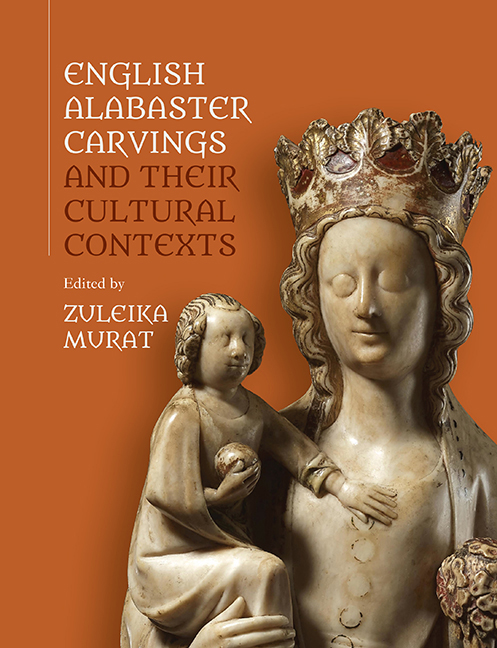Book contents
- Frontmatter
- CONTENTS
- List of Illustrations
- Acknowledgements
- List of Contributors
- Introduction
- 1 ‘Burton-Upon-Trent, Not Nottingham.’ the Evolving Study Of Medieval English Alabaster Sculpture
- 2 Stone to Ensure Victory and to Generate Friendships. On The Meaning of Alabaster
- 3 Contextualising English Alabasters in the Material Culture of the Medieval Mediterranean
- 4 English Alabaster Images As Recipients of Music in the Long Fifteenth Century: English Sacred Traditions in a European Perspective
- 5 Contextualising Alabasters in Their Immersive Environment. The ‘Ancona D'Allabastro Di Diverse Figure’ of the Novalesa Abbey: Meaning and Function
- 6 Alabaster Carvings in Late-Medieval Lincolnshire
- 7 ‘Tabernacles, Howsynges and Other Things’. Three Alabasters From the Burrell Collection in Context
- 8 Conservation Study of Three Alabaster Carvings From the Burrell Collection, Glasgow Museums
- 9 ‘Smooth as Monumental Alabaster’. the Alabaster Tomb Industry in England 1550–1660
- 10 Merchants’ Tombs in Alabaster
- 11 Exploring Alice: the Theological, Socio-Historical, and Anatomical Context of the De La Pole Cadaver Sculpture
- Bibliography
- Index
- Already Published
9 - ‘Smooth as Monumental Alabaster’. the Alabaster Tomb Industry in England 1550–1660
Published online by Cambridge University Press: 14 September 2019
- Frontmatter
- CONTENTS
- List of Illustrations
- Acknowledgements
- List of Contributors
- Introduction
- 1 ‘Burton-Upon-Trent, Not Nottingham.’ the Evolving Study Of Medieval English Alabaster Sculpture
- 2 Stone to Ensure Victory and to Generate Friendships. On The Meaning of Alabaster
- 3 Contextualising English Alabasters in the Material Culture of the Medieval Mediterranean
- 4 English Alabaster Images As Recipients of Music in the Long Fifteenth Century: English Sacred Traditions in a European Perspective
- 5 Contextualising Alabasters in Their Immersive Environment. The ‘Ancona D'Allabastro Di Diverse Figure’ of the Novalesa Abbey: Meaning and Function
- 6 Alabaster Carvings in Late-Medieval Lincolnshire
- 7 ‘Tabernacles, Howsynges and Other Things’. Three Alabasters From the Burrell Collection in Context
- 8 Conservation Study of Three Alabaster Carvings From the Burrell Collection, Glasgow Museums
- 9 ‘Smooth as Monumental Alabaster’. the Alabaster Tomb Industry in England 1550–1660
- 10 Merchants’ Tombs in Alabaster
- 11 Exploring Alice: the Theological, Socio-Historical, and Anatomical Context of the De La Pole Cadaver Sculpture
- Bibliography
- Index
- Already Published
Summary
When Othello described Desdemona as possessing ‘that whiter skin of hers than Snow, And smooth as monumental alabaster’, Shakespeare was referring to the Elizabethan and Jacobean predilection for a white and smooth female complexion that could be represented on a monumental effigy by well-chosen white alabaster. However the alabaster available to English sculptors working between 1550 and 1660 did not always allow them to use the ideal pure white material and some deliberately exploited differences in colour in the architectural elements of their work. The introduction of Carrara marble early in the seventeenth century for the monuments of Elizabeth I and Mary Queen of Scots was the initial move away from alabaster as the primary material for monuments, a move that was largely complete by the end of the century although alabaster held primacy until 1660 and did so longer outside London.
By the fifteenth century, alabaster tomb production was concentrated in the alabaster-producing areas of the Midlands and run by Englishmen. Such tombs were only very occasionally carved in London and York. London-made alabaster tombs of the first half of the sixteenth century are very few, but the picture changed after 1550 – gradually at first, but gathering speed by the 1570s. The influx of Netherlandish refugees in the late 1560s and beyond led to the establishment of tomb workshops in Southwark and London.
William Cure, a Dutchman, was brought to England to work on Henry VIII's palace of Nonsuch. We still do not know what work Cure did after Nonsuch but both the Marblers’ and Masons’ Companies in London were interested in his activities, suggesting that he was concentrating on producing monumental brasses and alabaster tombs. His son Cornelius was made a freeman of the Marblers’ Company in 1574 and moved to the Masons’ when that company subsumed the marblers in 1585. As master mason to James I he made the monument to Mary Queen of Scots, thus helping to begin the trend to replace alabaster with Italian marble. A series of alabaster tombs has been linked to him convincingly. For instance, a payment in 1584 by the Earl of Leicester may link him to that at St Mary's, Warwick, for Leicester's small son who died that year (Fig. 9.1).
- Type
- Chapter
- Information
- English Alabaster Carvings and their Cultural Contexts , pp. 214 - 235Publisher: Boydell & BrewerPrint publication year: 2019



